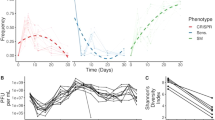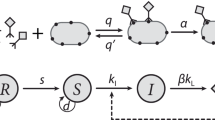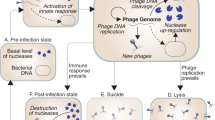Abstract
The evolution of competitive interactions among viruses1 was studied in the RNA phage φ6 at high and low multiplicities of infection (that is, at high and low ratios of infecting phage to host cells). At high multiplicities, many phage infect and reproduce in the same host cell, whereas at low multiplicities the viruses reproduce mainly as clones. An unexpected result of this study1 was that phage grown at high rates of co-infection increased in fitness initially, but then evolved lowered fitness. Here we show that the fitness of the high-multiplicity phage relative to their ancestors generates a pay-off matrix conforming to the prisoner's dilemma strategy of game theory2,3. In this strategy, defection (selfishness) evolves, despite the greater fitness pay-off that would result if all players were to cooperate. Viral cooperation and defection can be defined as, respectively, the manufacturing and sequestering of diffusible (shared) intracellular products. Because the low-multiplicity phage did not evolve lowered fitness, we attribute the evolution of selfishness to the lack of clonal structure and the mixing of unrelated genotypes at high multiplicity4,5,6.
This is a preview of subscription content, access via your institution
Access options
Subscribe to this journal
Receive 51 print issues and online access
We are sorry, but there is no personal subscription option available for your country.
Buy this article
- Purchase on SpringerLink
- Instant access to full article PDF
Prices may be subject to local taxes which are calculated during checkout


Similar content being viewed by others
References
Turner, P. E. & Chao, L. Sex and the evolution of intrahost competition in RNA virus φ6. Genetics 150, 523–532 (1998).
Axelrod, R. & Hamilton, W. D. The evolution of cooperation. Science 211, 1390–1396 (1981).
Maynard-Smith, J. Evolution and the Theory of Games(Cambridge Univ. Press, Cambridge, (1982)).
Hamilton, W. D. Altruism and related phenomena, mainly in social insects. Annu. Rev. Ecol. Syst. 3, 193–232 (1972).
Frank, S. A. Akin selection model for the evolution of virulence. Proc. R. Soc. Lond. B 250, 195–197 (1992).
Nowak, M. A. & May, R. M. Superinfection and the evolution of parasite virulence. Proc. R. Soc. Lond. B 255, 81–89 (1994).
Craig, J. L. Are communal pukeko caught in a Prisoner's Dilemma? Behav. Ecol. Sociobiol. 14, 147–150 (1984).
Fischer, E. A. Simultaneous hermaphroditism, Tit for Tat, and the evolutionary stability of social systems. Ethol. Sociobiol. 9, 119–136 (1988).
Chao, L. Evolution of polyandry in a communal breeding system. Behav. Ecol. 8, 668–674 (1997).
Dugatkin, L. A. Cooperation Among Animals: an Evolutionary Perspective(Oxford Univ. Press, Oxford, (1997)).
von Magnus, P. Incomplete forms of influenza virus. Adv. Virus Res. 2, 59–79 (1954).
Lewontin, R. C. The units of selection. Annu. Rev. Ecol. Syst. 1, 1–18 (1970).
Bonhoeffer, S. & Nowak, M. A. Intra-host and inter-host selection: viral evolution of immune function impairment. Proc. Natl Acad. Sci. USA 91, 8062–8066 (1994).
Huang, A. S. & Baltimore, D. Defective viral particles and viral disease processes. Nature 226, 325–327 (1970).
Holland, J. Fundamental Virology 2nd edn(eds Fields, B. & Knipe, D.) 151–165 (Raven, New York, (1991)).
Chao, L. The Evolutionary Biology of Viruses(ed. Morse, S. S.) 233–250 (Raven, New York, (1994)).
Mindich, L., Cohen, J. & Weisburd, M. Isolation of nonsense suppressor mutants in Pseudomonas. J.Bact. 126, 177–182 (1976).
Stent, G. Molecular Biology of Bacterial Viruses(Freeman, San Francisco, (1963)).
Nowak, M. & May, R. Evolutionary games and spatial chaos. Nature 359, 826–829 (1992).
Herre, E. A. Population structure and the evolution of virulence in nematode parasites of fig wasps. Science 259, 1442–1445 (1993).
Frank, S. A. Models of parasite virulence. Q. Rev. Biol. 71, 37–78 (1996).
Hamilton, W. D. The genetical evolution of social behavior: I and II. J. Theor. Biol. 7, 1–52 (1964).
Bremermann, H. J. & Pickering, J. Agame-theoretical model of parasite virulence. J. Theor. Biol. 100, 411–426 (1983).
Knolle, H. Host density and the evolution of parasite virulence. J. Theor. Biol. 136, 199–207 (1989).
Fisher, R. A. The Genetical Theory of Natural Selection(Clarendon, Oxford, (1930)).
Sinclair, J. F., Cohen, J. & Mindich, L. The isolation of suppressible nonsense mutants of bacteriophage φ6. Virology 75, 198–208 (1976).
Vidaver, K. A., Koski, R. K. & Van Etten, J. L. Bacteriophage φ6: a lipid-containing virus of Pseudomonas phaseolicola. J. Virol. 11, 799–805 (1973).
Acknowledgements
We thank C. Burch, K. Hanley, S. Lance, U. Mueller, J. Smale and G. Wilkinson for useful comments and enlightening discussion. This work was supported by fellowships from the NSF and University of Maryland to P.E.T.
Author information
Authors and Affiliations
Corresponding author
Rights and permissions
About this article
Cite this article
Turner, P., Chao, L. Prisoner's dilemma in an RNA virus. Nature 398, 441–443 (1999). https://doi.org/10.1038/18913
Received:
Accepted:
Issue Date:
DOI: https://doi.org/10.1038/18913



